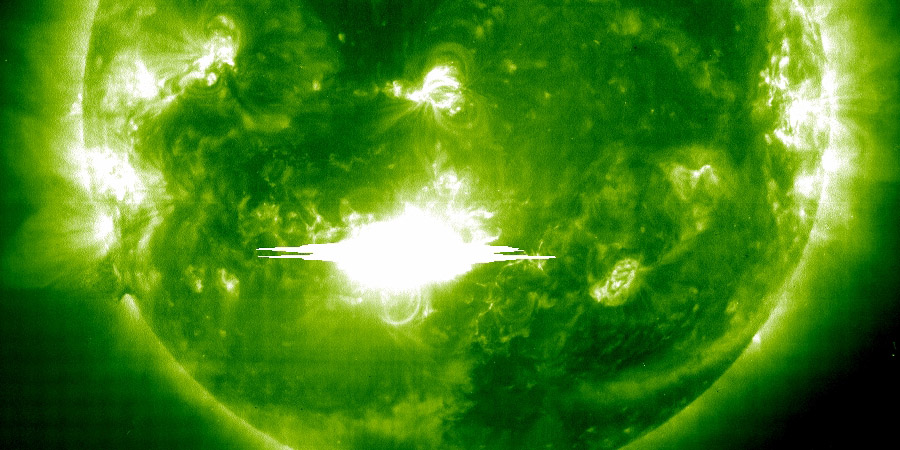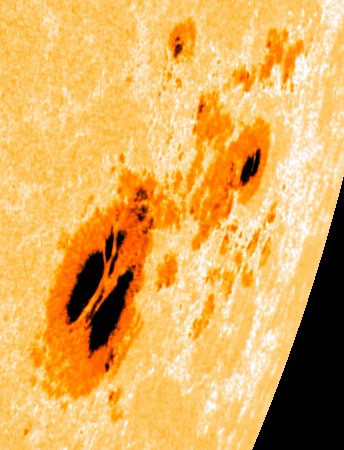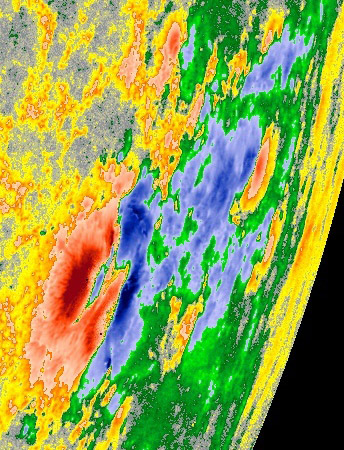2003 Halloween solar storms, sunspot region 2192
Tuesday, 28 October 2014 16:30 UTC

It is today exactly 11 years ago that sunspot region 486 erupted with a massive X17.2 solar flare (see header image as well). This was one of many strong solar flares caused by three large and impressive sunspot regions during solar cycle 23. It was also during this period that the largest solar flare in modern times erupted: an extreme X28 (which might have been as strong as X45) solar flare on 4 November 2003 by sunspot region 486. These three regions launched numerous coronal mass ejections towards Earth causing several days of extreme geomagnetic storming. Aurora was seen from latitudes as low as Portugal and even Texas! Last year we made a special video to celebrate these so called ''Halloween solar storms of 2003'' and today we are going to dust of this video and show it one more time. But back to today: of course we still have sunspot region 2192 on the earth-facing solar disk which has been erupting with an occasional M-class solar flare today. In this article we will also take a closer look at sunspot region 2192.
11 years ago - The Halloween Solar Storms of 2003
Evolution of sunspot region 2192
Solar activity has been high since our our last update with a couple of M-class solar flares but we haven't seen an X-class solar flare. The strongest solar flare in the past 24 hours was an M6.6 (R2-moderate) solar flare at 03:32 UTC but as you might have guessed already, there were no coronal mass ejections associated with any of these events.
Sunspot region 2192 continues to slowly decay again loosing penumbral area and some smaller umbra spots. Most of the decay continues to occur in it's intermediate layout and around the leader spot but also the trailer spots seems to be decaying now. Three delta sunspots have decayed but at least four small delta sunspots remain where they are. While sunspot region 2192 remains a large and magnetically complex sunspot region we can conclude that it did loose magnetic complexity during the past 24 hours. We can still expect M-class (R1-R2) activity in the coming 24 hours but X-class solar flares are becoming less likely. We slightly lower the solar flare probability percantages today compared to yesterday.
M-class flare probability: 70% chance
X-class flare probability: 25% chance
We do need to note that sunspot region 2192 is now coming really close to the west limb making accurate measurements of this sunspot region it's complexity more and more difficult. This will likely be the last update that we can give where we can discuss how complex sunspot region 2192 is. In the next 24 to 48 hours, sunspot region 2192 will rotate off the Earth-facing soalr disk and start its 2-week transit of the far side. If it survives, it could return the second week in November.
A strong eruption from sunspot region 2192 could still result in a solar radiation storm at Earth which would impact HF radio communications at arctic latitudes.


All the other sunspot regions on the disk are unremarkable. Any future solar flares will very likely be centered around sunspot region 2192.
Images: NASA SDO and ESA/NASA SOHO.
Video: see YouTube description.
Thank you for reading this article! Did you have any trouble with the technical terms used in this article? Our help section is the place to be where you can find in-depth articles, a FAQ and a list with common abbreviations. Still puzzled? Just post on our forum where we will help you the best we can!
Latest news
Latest forum messages
Support SpaceWeatherLive.com!
A lot of people come to SpaceWeatherLive to follow the Sun's activity or if there is aurora to be seen, but with more traffic comes higher server costs. Consider a donation if you enjoy SpaceWeatherLive so we can keep the website online!

Space weather facts
| Last X-flare | 2024/03/28 | X1.1 |
| Last M-flare | 2024/04/19 | M1.0 |
| Last geomagnetic storm | 2024/04/16 | Kp5 (G1) |
| Spotless days | |
|---|---|
| Last spotless day | 2022/06/08 |
| Monthly mean Sunspot Number | |
|---|---|
| March 2024 | 104.9 -19.8 |


